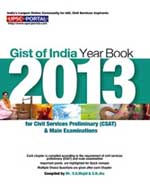(HOT) UPSC Current Affairs 2025 PDF
NEW! The Gist (OCT-2025) | E-BOOKS
(Sample Materials) Gist of India Year Book 2013 - "Transport"
Contents of the Chapter:
- Intoduction National Waterways
- Railways
- Civil Aviation
- Roads
- Shipping
- Coastal Shipping
- Maritime Training
- MCQs for Final Practice
Introduction
Transportation plays an important role in the development of country. The Ministry of Shipping, Ministry of Road Transport and Highways is responsible for the formation and implementation of policies and programmes for the development of various modes of transport save the railways and the civil aviation.
Railways
The Railways in India provide the principal mode of transportation for freight and passengers. The first train steamed off from Mumbai to Thane in 1853. Now it has played a vital role in the economic, industrial and social development of the country.
Indian Railways have grown into a vast network of 7,133 stations spread over a rout length of 64,460 km with a fleet of 9,213 locomotives, 53,220 passenger service vehicles, 6,493 other coaching vehicles and 2,29,381 wagons as o 31st March, 2011.
About 30 per cent of the route kilometre, 41 per cent of running track kilometre and 43 per cent of total track kilometre is electrified. The network is divided into 17 zones. Divisions are the basic operating units. The 17 zones and their respoective headquarters are given below:
1. Consider the following statements:
- Cape Town convention is related to better financing of Civil Aviation sector.
- Government of India accepted it in the year 2008.
Which of the above statements is / are correct?
- 1 only
- 2 only
- Both 2 & 3
- Neither 1 nor 2
Click Here to Download Full Chapter


